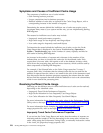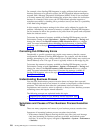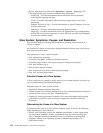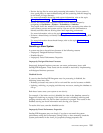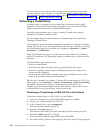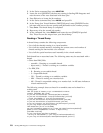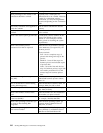To resolve this, you may have to make changes to the appropriate performance
tuning properties either manually or using the Performance Tuning Utility. For
more information about performance tuning, refer to “Performance Tuning Utility”
on page 120 or Manual Performance Tuning.
Performing a Thread Dump
A thread dump is a snapshot of every thread that is running in Sterling B2B
Integrator at the time the thread dump is generated. You can perform a thread
dump to determine bottlenecks in Sterling B2B Integrator.
Typically, problem threads are in a state of waiting. Threads with a state of
runnable or R indicate a healthy thread.
For information about the different states of a thread dump, refer to the topic
"Reading a Thread Dump."
The subsequent sections describe command-line methods for working with thread
dumps. You can also work with thread dumps from the user interface by accessing
the JVM Monitor page that is available by navigating to Operations > System >
Performance > JVM Monitor.
Note: The JVM Monitor page is available only for Linux, IBM AIX, Sun Solaris,
and HP-UX platforms. The heap dump option is available only on Linux and AIX
platforms.
The JVM Monitor page enables you to:
v Perform a thread dump.
v Download and delete the dumps that are conducted from the system.
v Enable GC (garbage collector) output. Enabling causes the GC output to be
written into the noapp.log.
v (Linux and AIX only) Enable or disable heap dumps. Enabling causes a heap
dump to be generated along with thread dumps.
Tip: For the Command Line Adapter 2 (Version 5.2.4.1 and interim fix 5.2.4.1_2 or
later), when you use Operations > System > JVM Monitor > Take Thread Dump,
the default Command Line Adapter 2 must match the CLA2_PORT in the
sandbox.cfg to take thread dumps from the User Interface. You can also use the
command line to take a thread dump with the shell script.
Performing a Thread Dump in UNIX (HP-UX or Sun Solaris)
To perform a thread dump in UNIX (HP-UX or Sun Solaris):
1. Access the computer on which Sterling B2B Integrator is installed.
2. Change your working directory to install_dir.
3. In the command line, enter cat noapp.pid.
This lists the parent thread process ID.
4. Enter ps -ef | grep noapp.pid.
This returns all the child process IDs associated with the parent process ID.
5. Enter kill -QUIT noapp.pid child.pid.
(You must include both the parent PID and the child PID.)
6. The thread dump is placed in the noapp.log file in the install_dir/logs directory.
236 Sterling B2B Integrator: Performance Management



